Marketing - Shopping Mall Experience
VerifiedAdded on 2022/08/21
|10
|2864
|11
AI Summary
Contribute Materials
Your contribution can guide someone’s learning journey. Share your
documents today.

Running head: MARKETING
Marketing
Name of student
Name of University
Author note
Marketing
Name of student
Name of University
Author note
Secure Best Marks with AI Grader
Need help grading? Try our AI Grader for instant feedback on your assignments.
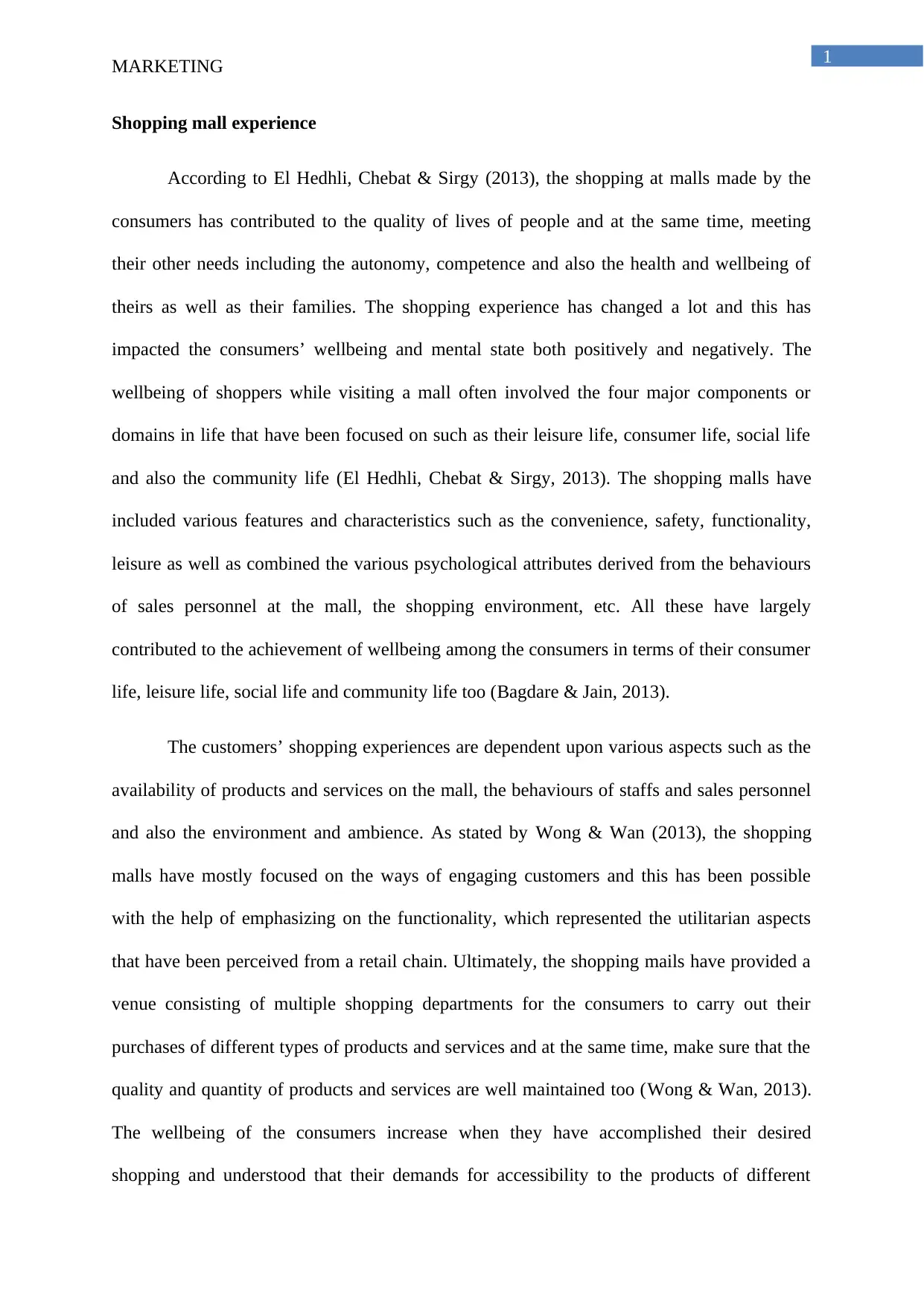
1
MARKETING
Shopping mall experience
According to El Hedhli, Chebat & Sirgy (2013), the shopping at malls made by the
consumers has contributed to the quality of lives of people and at the same time, meeting
their other needs including the autonomy, competence and also the health and wellbeing of
theirs as well as their families. The shopping experience has changed a lot and this has
impacted the consumers’ wellbeing and mental state both positively and negatively. The
wellbeing of shoppers while visiting a mall often involved the four major components or
domains in life that have been focused on such as their leisure life, consumer life, social life
and also the community life (El Hedhli, Chebat & Sirgy, 2013). The shopping malls have
included various features and characteristics such as the convenience, safety, functionality,
leisure as well as combined the various psychological attributes derived from the behaviours
of sales personnel at the mall, the shopping environment, etc. All these have largely
contributed to the achievement of wellbeing among the consumers in terms of their consumer
life, leisure life, social life and community life too (Bagdare & Jain, 2013).
The customers’ shopping experiences are dependent upon various aspects such as the
availability of products and services on the mall, the behaviours of staffs and sales personnel
and also the environment and ambience. As stated by Wong & Wan (2013), the shopping
malls have mostly focused on the ways of engaging customers and this has been possible
with the help of emphasizing on the functionality, which represented the utilitarian aspects
that have been perceived from a retail chain. Ultimately, the shopping mails have provided a
venue consisting of multiple shopping departments for the consumers to carry out their
purchases of different types of products and services and at the same time, make sure that the
quality and quantity of products and services are well maintained too (Wong & Wan, 2013).
The wellbeing of the consumers increase when they have accomplished their desired
shopping and understood that their demands for accessibility to the products of different
MARKETING
Shopping mall experience
According to El Hedhli, Chebat & Sirgy (2013), the shopping at malls made by the
consumers has contributed to the quality of lives of people and at the same time, meeting
their other needs including the autonomy, competence and also the health and wellbeing of
theirs as well as their families. The shopping experience has changed a lot and this has
impacted the consumers’ wellbeing and mental state both positively and negatively. The
wellbeing of shoppers while visiting a mall often involved the four major components or
domains in life that have been focused on such as their leisure life, consumer life, social life
and also the community life (El Hedhli, Chebat & Sirgy, 2013). The shopping malls have
included various features and characteristics such as the convenience, safety, functionality,
leisure as well as combined the various psychological attributes derived from the behaviours
of sales personnel at the mall, the shopping environment, etc. All these have largely
contributed to the achievement of wellbeing among the consumers in terms of their consumer
life, leisure life, social life and community life too (Bagdare & Jain, 2013).
The customers’ shopping experiences are dependent upon various aspects such as the
availability of products and services on the mall, the behaviours of staffs and sales personnel
and also the environment and ambience. As stated by Wong & Wan (2013), the shopping
malls have mostly focused on the ways of engaging customers and this has been possible
with the help of emphasizing on the functionality, which represented the utilitarian aspects
that have been perceived from a retail chain. Ultimately, the shopping mails have provided a
venue consisting of multiple shopping departments for the consumers to carry out their
purchases of different types of products and services and at the same time, make sure that the
quality and quantity of products and services are well maintained too (Wong & Wan, 2013).
The wellbeing of the consumers increase when they have accomplished their desired
shopping and understood that their demands for accessibility to the products of different
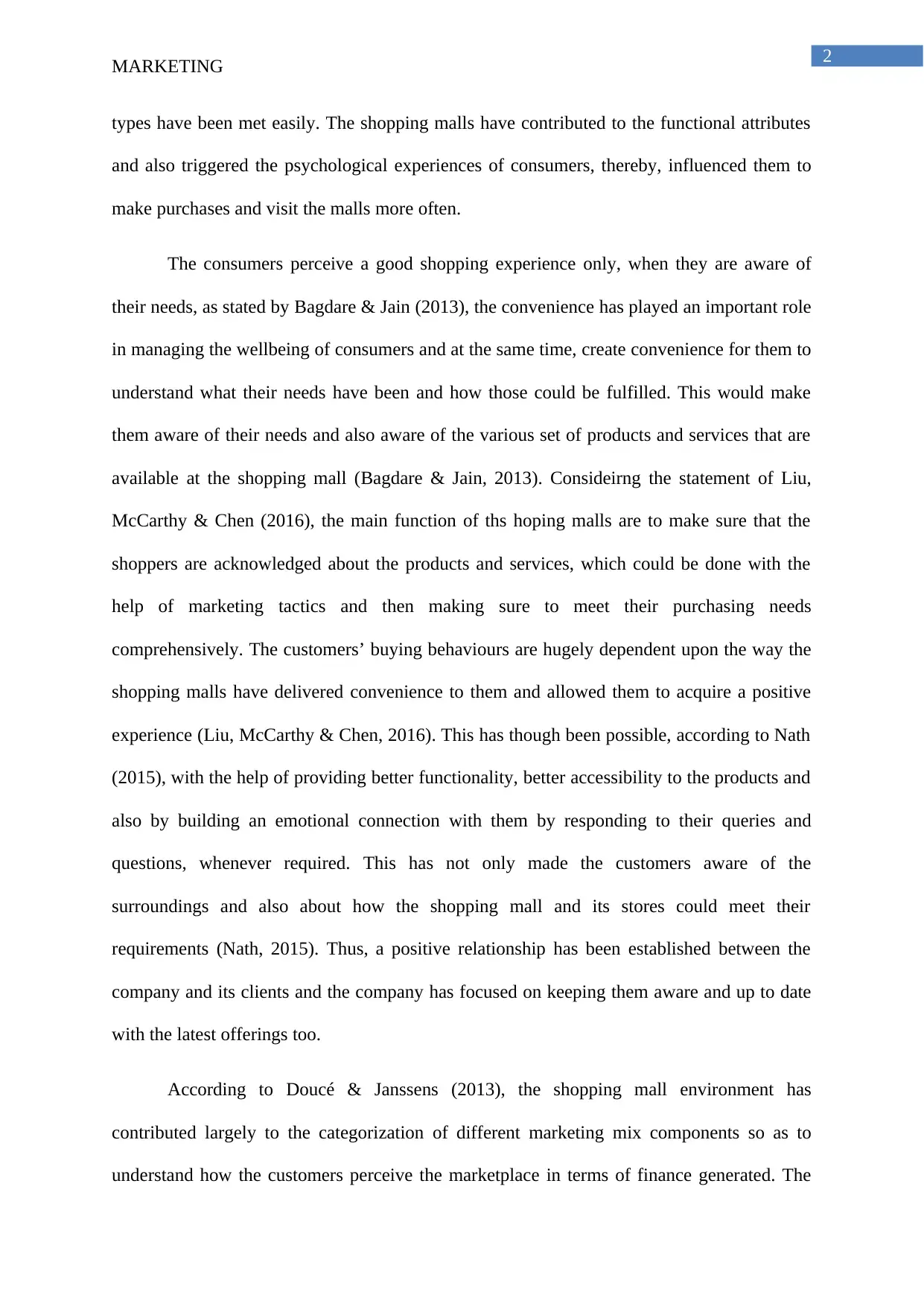
2
MARKETING
types have been met easily. The shopping malls have contributed to the functional attributes
and also triggered the psychological experiences of consumers, thereby, influenced them to
make purchases and visit the malls more often.
The consumers perceive a good shopping experience only, when they are aware of
their needs, as stated by Bagdare & Jain (2013), the convenience has played an important role
in managing the wellbeing of consumers and at the same time, create convenience for them to
understand what their needs have been and how those could be fulfilled. This would make
them aware of their needs and also aware of the various set of products and services that are
available at the shopping mall (Bagdare & Jain, 2013). Consideirng the statement of Liu,
McCarthy & Chen (2016), the main function of ths hoping malls are to make sure that the
shoppers are acknowledged about the products and services, which could be done with the
help of marketing tactics and then making sure to meet their purchasing needs
comprehensively. The customers’ buying behaviours are hugely dependent upon the way the
shopping malls have delivered convenience to them and allowed them to acquire a positive
experience (Liu, McCarthy & Chen, 2016). This has though been possible, according to Nath
(2015), with the help of providing better functionality, better accessibility to the products and
also by building an emotional connection with them by responding to their queries and
questions, whenever required. This has not only made the customers aware of the
surroundings and also about how the shopping mall and its stores could meet their
requirements (Nath, 2015). Thus, a positive relationship has been established between the
company and its clients and the company has focused on keeping them aware and up to date
with the latest offerings too.
According to Doucé & Janssens (2013), the shopping mall environment has
contributed largely to the categorization of different marketing mix components so as to
understand how the customers perceive the marketplace in terms of finance generated. The
MARKETING
types have been met easily. The shopping malls have contributed to the functional attributes
and also triggered the psychological experiences of consumers, thereby, influenced them to
make purchases and visit the malls more often.
The consumers perceive a good shopping experience only, when they are aware of
their needs, as stated by Bagdare & Jain (2013), the convenience has played an important role
in managing the wellbeing of consumers and at the same time, create convenience for them to
understand what their needs have been and how those could be fulfilled. This would make
them aware of their needs and also aware of the various set of products and services that are
available at the shopping mall (Bagdare & Jain, 2013). Consideirng the statement of Liu,
McCarthy & Chen (2016), the main function of ths hoping malls are to make sure that the
shoppers are acknowledged about the products and services, which could be done with the
help of marketing tactics and then making sure to meet their purchasing needs
comprehensively. The customers’ buying behaviours are hugely dependent upon the way the
shopping malls have delivered convenience to them and allowed them to acquire a positive
experience (Liu, McCarthy & Chen, 2016). This has though been possible, according to Nath
(2015), with the help of providing better functionality, better accessibility to the products and
also by building an emotional connection with them by responding to their queries and
questions, whenever required. This has not only made the customers aware of the
surroundings and also about how the shopping mall and its stores could meet their
requirements (Nath, 2015). Thus, a positive relationship has been established between the
company and its clients and the company has focused on keeping them aware and up to date
with the latest offerings too.
According to Doucé & Janssens (2013), the shopping mall environment has
contributed largely to the categorization of different marketing mix components so as to
understand how the customers perceive the marketplace in terms of finance generated. The
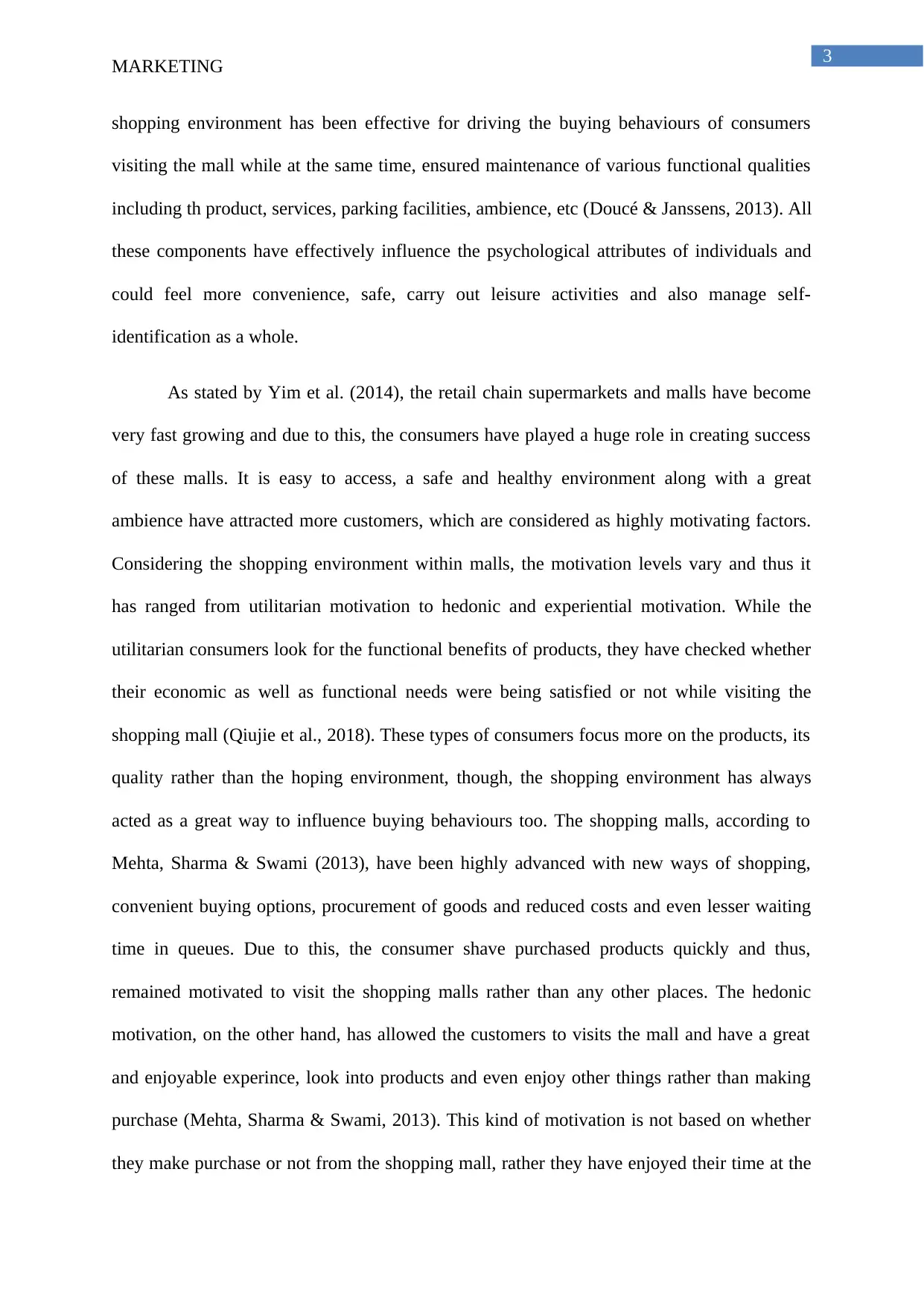
3
MARKETING
shopping environment has been effective for driving the buying behaviours of consumers
visiting the mall while at the same time, ensured maintenance of various functional qualities
including th product, services, parking facilities, ambience, etc (Doucé & Janssens, 2013). All
these components have effectively influence the psychological attributes of individuals and
could feel more convenience, safe, carry out leisure activities and also manage self-
identification as a whole.
As stated by Yim et al. (2014), the retail chain supermarkets and malls have become
very fast growing and due to this, the consumers have played a huge role in creating success
of these malls. It is easy to access, a safe and healthy environment along with a great
ambience have attracted more customers, which are considered as highly motivating factors.
Considering the shopping environment within malls, the motivation levels vary and thus it
has ranged from utilitarian motivation to hedonic and experiential motivation. While the
utilitarian consumers look for the functional benefits of products, they have checked whether
their economic as well as functional needs were being satisfied or not while visiting the
shopping mall (Qiujie et al., 2018). These types of consumers focus more on the products, its
quality rather than the hoping environment, though, the shopping environment has always
acted as a great way to influence buying behaviours too. The shopping malls, according to
Mehta, Sharma & Swami (2013), have been highly advanced with new ways of shopping,
convenient buying options, procurement of goods and reduced costs and even lesser waiting
time in queues. Due to this, the consumer shave purchased products quickly and thus,
remained motivated to visit the shopping malls rather than any other places. The hedonic
motivation, on the other hand, has allowed the customers to visits the mall and have a great
and enjoyable experince, look into products and even enjoy other things rather than making
purchase (Mehta, Sharma & Swami, 2013). This kind of motivation is not based on whether
they make purchase or not from the shopping mall, rather they have enjoyed their time at the
MARKETING
shopping environment has been effective for driving the buying behaviours of consumers
visiting the mall while at the same time, ensured maintenance of various functional qualities
including th product, services, parking facilities, ambience, etc (Doucé & Janssens, 2013). All
these components have effectively influence the psychological attributes of individuals and
could feel more convenience, safe, carry out leisure activities and also manage self-
identification as a whole.
As stated by Yim et al. (2014), the retail chain supermarkets and malls have become
very fast growing and due to this, the consumers have played a huge role in creating success
of these malls. It is easy to access, a safe and healthy environment along with a great
ambience have attracted more customers, which are considered as highly motivating factors.
Considering the shopping environment within malls, the motivation levels vary and thus it
has ranged from utilitarian motivation to hedonic and experiential motivation. While the
utilitarian consumers look for the functional benefits of products, they have checked whether
their economic as well as functional needs were being satisfied or not while visiting the
shopping mall (Qiujie et al., 2018). These types of consumers focus more on the products, its
quality rather than the hoping environment, though, the shopping environment has always
acted as a great way to influence buying behaviours too. The shopping malls, according to
Mehta, Sharma & Swami (2013), have been highly advanced with new ways of shopping,
convenient buying options, procurement of goods and reduced costs and even lesser waiting
time in queues. Due to this, the consumer shave purchased products quickly and thus,
remained motivated to visit the shopping malls rather than any other places. The hedonic
motivation, on the other hand, has allowed the customers to visits the mall and have a great
and enjoyable experince, look into products and even enjoy other things rather than making
purchase (Mehta, Sharma & Swami, 2013). This kind of motivation is not based on whether
they make purchase or not from the shopping mall, rather they have enjoyed their time at the
Secure Best Marks with AI Grader
Need help grading? Try our AI Grader for instant feedback on your assignments.
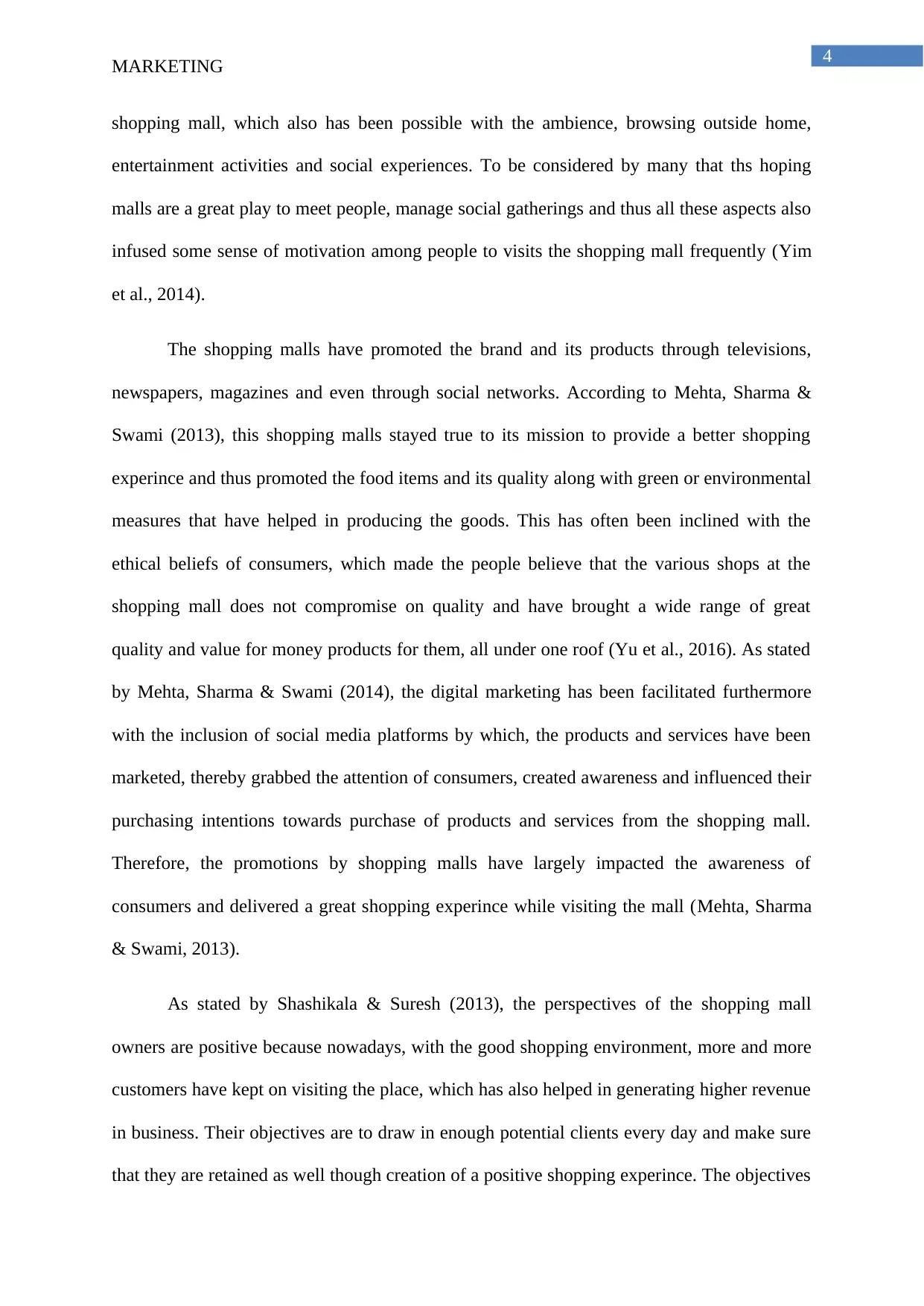
4
MARKETING
shopping mall, which also has been possible with the ambience, browsing outside home,
entertainment activities and social experiences. To be considered by many that ths hoping
malls are a great play to meet people, manage social gatherings and thus all these aspects also
infused some sense of motivation among people to visits the shopping mall frequently (Yim
et al., 2014).
The shopping malls have promoted the brand and its products through televisions,
newspapers, magazines and even through social networks. According to Mehta, Sharma &
Swami (2013), this shopping malls stayed true to its mission to provide a better shopping
experince and thus promoted the food items and its quality along with green or environmental
measures that have helped in producing the goods. This has often been inclined with the
ethical beliefs of consumers, which made the people believe that the various shops at the
shopping mall does not compromise on quality and have brought a wide range of great
quality and value for money products for them, all under one roof (Yu et al., 2016). As stated
by Mehta, Sharma & Swami (2014), the digital marketing has been facilitated furthermore
with the inclusion of social media platforms by which, the products and services have been
marketed, thereby grabbed the attention of consumers, created awareness and influenced their
purchasing intentions towards purchase of products and services from the shopping mall.
Therefore, the promotions by shopping malls have largely impacted the awareness of
consumers and delivered a great shopping experince while visiting the mall (Mehta, Sharma
& Swami, 2013).
As stated by Shashikala & Suresh (2013), the perspectives of the shopping mall
owners are positive because nowadays, with the good shopping environment, more and more
customers have kept on visiting the place, which has also helped in generating higher revenue
in business. Their objectives are to draw in enough potential clients every day and make sure
that they are retained as well though creation of a positive shopping experince. The objectives
MARKETING
shopping mall, which also has been possible with the ambience, browsing outside home,
entertainment activities and social experiences. To be considered by many that ths hoping
malls are a great play to meet people, manage social gatherings and thus all these aspects also
infused some sense of motivation among people to visits the shopping mall frequently (Yim
et al., 2014).
The shopping malls have promoted the brand and its products through televisions,
newspapers, magazines and even through social networks. According to Mehta, Sharma &
Swami (2013), this shopping malls stayed true to its mission to provide a better shopping
experince and thus promoted the food items and its quality along with green or environmental
measures that have helped in producing the goods. This has often been inclined with the
ethical beliefs of consumers, which made the people believe that the various shops at the
shopping mall does not compromise on quality and have brought a wide range of great
quality and value for money products for them, all under one roof (Yu et al., 2016). As stated
by Mehta, Sharma & Swami (2014), the digital marketing has been facilitated furthermore
with the inclusion of social media platforms by which, the products and services have been
marketed, thereby grabbed the attention of consumers, created awareness and influenced their
purchasing intentions towards purchase of products and services from the shopping mall.
Therefore, the promotions by shopping malls have largely impacted the awareness of
consumers and delivered a great shopping experince while visiting the mall (Mehta, Sharma
& Swami, 2013).
As stated by Shashikala & Suresh (2013), the perspectives of the shopping mall
owners are positive because nowadays, with the good shopping environment, more and more
customers have kept on visiting the place, which has also helped in generating higher revenue
in business. Their objectives are to draw in enough potential clients every day and make sure
that they are retained as well though creation of a positive shopping experince. The objectives
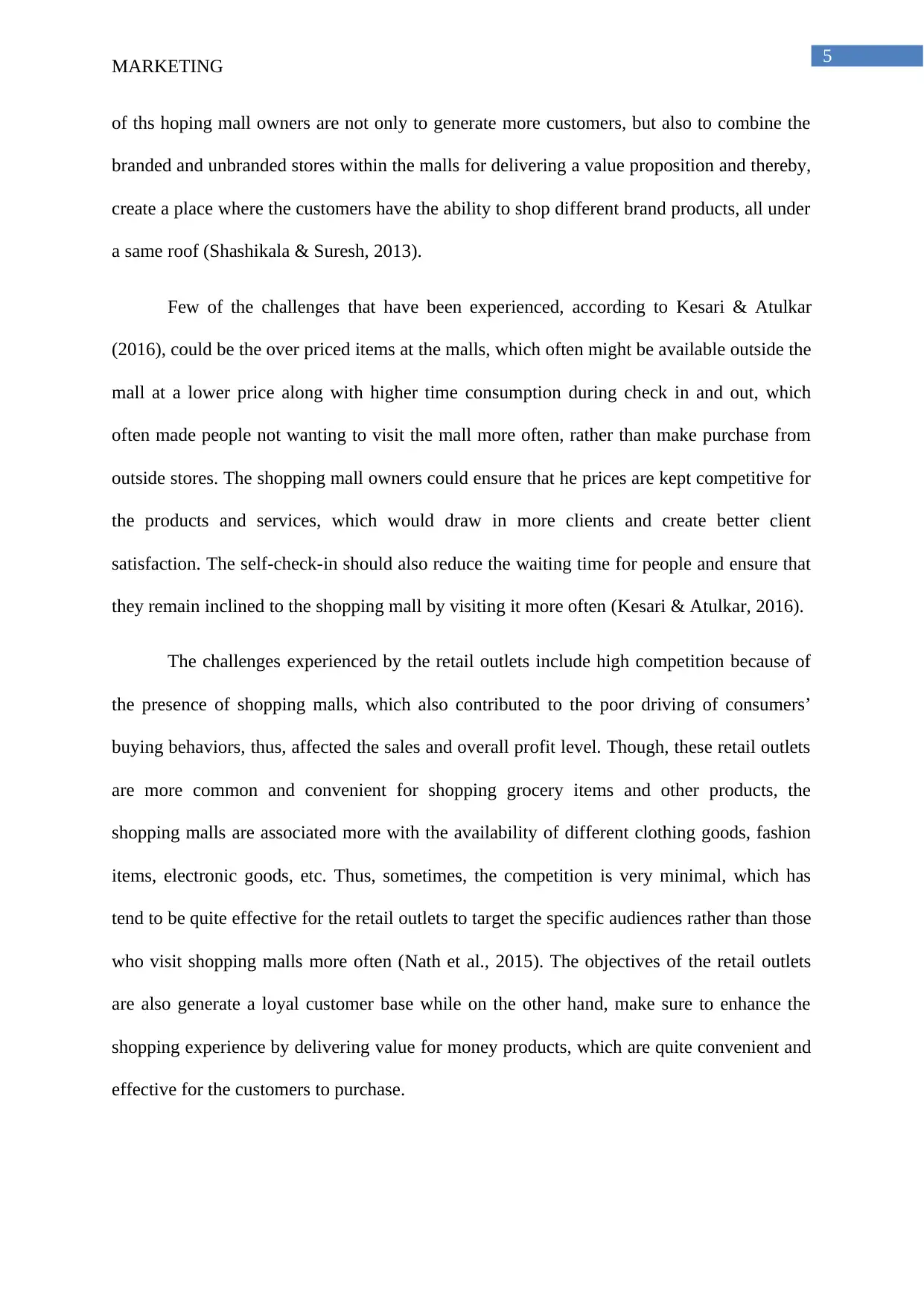
5
MARKETING
of ths hoping mall owners are not only to generate more customers, but also to combine the
branded and unbranded stores within the malls for delivering a value proposition and thereby,
create a place where the customers have the ability to shop different brand products, all under
a same roof (Shashikala & Suresh, 2013).
Few of the challenges that have been experienced, according to Kesari & Atulkar
(2016), could be the over priced items at the malls, which often might be available outside the
mall at a lower price along with higher time consumption during check in and out, which
often made people not wanting to visit the mall more often, rather than make purchase from
outside stores. The shopping mall owners could ensure that he prices are kept competitive for
the products and services, which would draw in more clients and create better client
satisfaction. The self-check-in should also reduce the waiting time for people and ensure that
they remain inclined to the shopping mall by visiting it more often (Kesari & Atulkar, 2016).
The challenges experienced by the retail outlets include high competition because of
the presence of shopping malls, which also contributed to the poor driving of consumers’
buying behaviors, thus, affected the sales and overall profit level. Though, these retail outlets
are more common and convenient for shopping grocery items and other products, the
shopping malls are associated more with the availability of different clothing goods, fashion
items, electronic goods, etc. Thus, sometimes, the competition is very minimal, which has
tend to be quite effective for the retail outlets to target the specific audiences rather than those
who visit shopping malls more often (Nath et al., 2015). The objectives of the retail outlets
are also generate a loyal customer base while on the other hand, make sure to enhance the
shopping experience by delivering value for money products, which are quite convenient and
effective for the customers to purchase.
MARKETING
of ths hoping mall owners are not only to generate more customers, but also to combine the
branded and unbranded stores within the malls for delivering a value proposition and thereby,
create a place where the customers have the ability to shop different brand products, all under
a same roof (Shashikala & Suresh, 2013).
Few of the challenges that have been experienced, according to Kesari & Atulkar
(2016), could be the over priced items at the malls, which often might be available outside the
mall at a lower price along with higher time consumption during check in and out, which
often made people not wanting to visit the mall more often, rather than make purchase from
outside stores. The shopping mall owners could ensure that he prices are kept competitive for
the products and services, which would draw in more clients and create better client
satisfaction. The self-check-in should also reduce the waiting time for people and ensure that
they remain inclined to the shopping mall by visiting it more often (Kesari & Atulkar, 2016).
The challenges experienced by the retail outlets include high competition because of
the presence of shopping malls, which also contributed to the poor driving of consumers’
buying behaviors, thus, affected the sales and overall profit level. Though, these retail outlets
are more common and convenient for shopping grocery items and other products, the
shopping malls are associated more with the availability of different clothing goods, fashion
items, electronic goods, etc. Thus, sometimes, the competition is very minimal, which has
tend to be quite effective for the retail outlets to target the specific audiences rather than those
who visit shopping malls more often (Nath et al., 2015). The objectives of the retail outlets
are also generate a loyal customer base while on the other hand, make sure to enhance the
shopping experience by delivering value for money products, which are quite convenient and
effective for the customers to purchase.
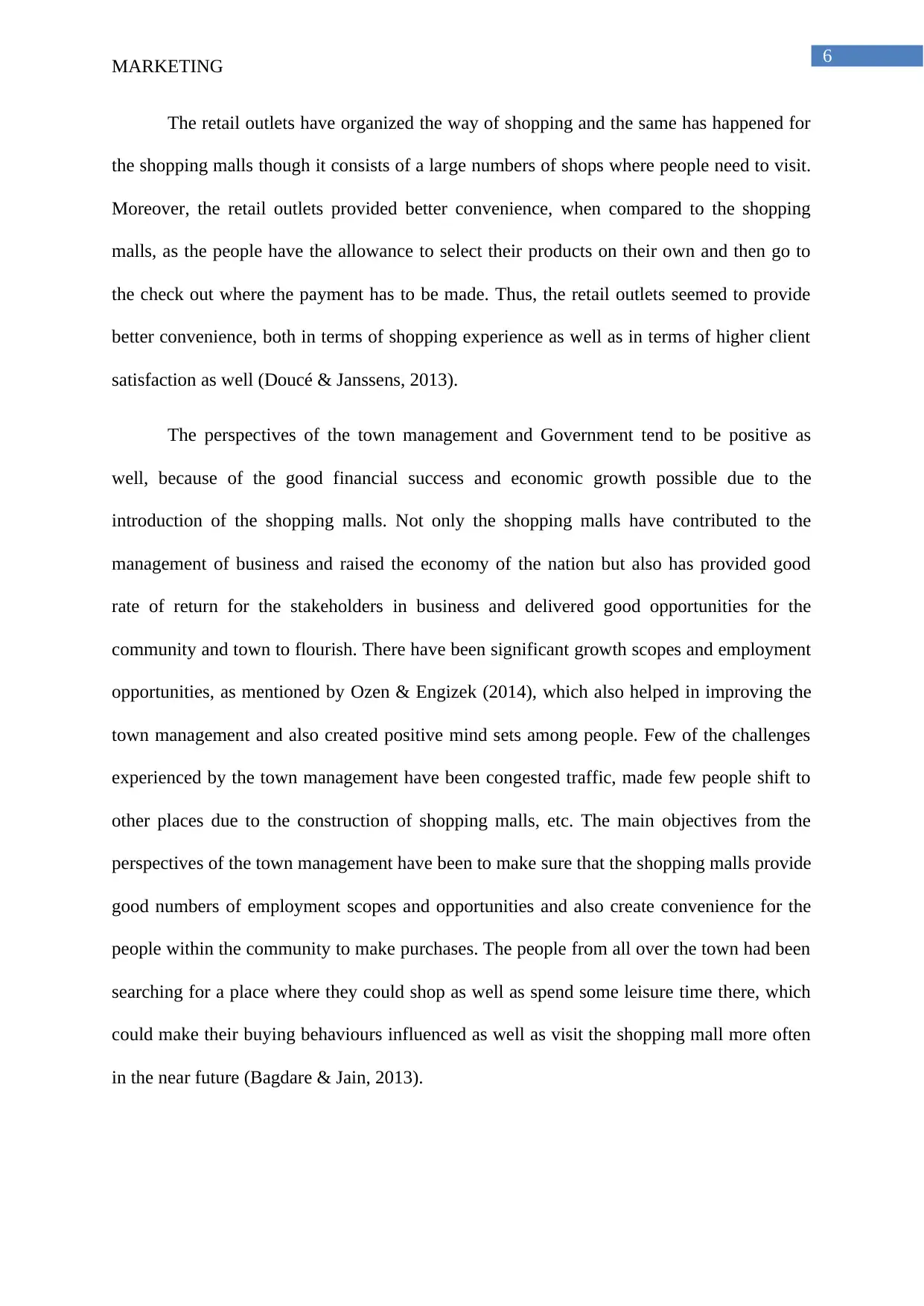
6
MARKETING
The retail outlets have organized the way of shopping and the same has happened for
the shopping malls though it consists of a large numbers of shops where people need to visit.
Moreover, the retail outlets provided better convenience, when compared to the shopping
malls, as the people have the allowance to select their products on their own and then go to
the check out where the payment has to be made. Thus, the retail outlets seemed to provide
better convenience, both in terms of shopping experience as well as in terms of higher client
satisfaction as well (Doucé & Janssens, 2013).
The perspectives of the town management and Government tend to be positive as
well, because of the good financial success and economic growth possible due to the
introduction of the shopping malls. Not only the shopping malls have contributed to the
management of business and raised the economy of the nation but also has provided good
rate of return for the stakeholders in business and delivered good opportunities for the
community and town to flourish. There have been significant growth scopes and employment
opportunities, as mentioned by Ozen & Engizek (2014), which also helped in improving the
town management and also created positive mind sets among people. Few of the challenges
experienced by the town management have been congested traffic, made few people shift to
other places due to the construction of shopping malls, etc. The main objectives from the
perspectives of the town management have been to make sure that the shopping malls provide
good numbers of employment scopes and opportunities and also create convenience for the
people within the community to make purchases. The people from all over the town had been
searching for a place where they could shop as well as spend some leisure time there, which
could make their buying behaviours influenced as well as visit the shopping mall more often
in the near future (Bagdare & Jain, 2013).
MARKETING
The retail outlets have organized the way of shopping and the same has happened for
the shopping malls though it consists of a large numbers of shops where people need to visit.
Moreover, the retail outlets provided better convenience, when compared to the shopping
malls, as the people have the allowance to select their products on their own and then go to
the check out where the payment has to be made. Thus, the retail outlets seemed to provide
better convenience, both in terms of shopping experience as well as in terms of higher client
satisfaction as well (Doucé & Janssens, 2013).
The perspectives of the town management and Government tend to be positive as
well, because of the good financial success and economic growth possible due to the
introduction of the shopping malls. Not only the shopping malls have contributed to the
management of business and raised the economy of the nation but also has provided good
rate of return for the stakeholders in business and delivered good opportunities for the
community and town to flourish. There have been significant growth scopes and employment
opportunities, as mentioned by Ozen & Engizek (2014), which also helped in improving the
town management and also created positive mind sets among people. Few of the challenges
experienced by the town management have been congested traffic, made few people shift to
other places due to the construction of shopping malls, etc. The main objectives from the
perspectives of the town management have been to make sure that the shopping malls provide
good numbers of employment scopes and opportunities and also create convenience for the
people within the community to make purchases. The people from all over the town had been
searching for a place where they could shop as well as spend some leisure time there, which
could make their buying behaviours influenced as well as visit the shopping mall more often
in the near future (Bagdare & Jain, 2013).
Paraphrase This Document
Need a fresh take? Get an instant paraphrase of this document with our AI Paraphraser

7
MARKETING
MARKETING
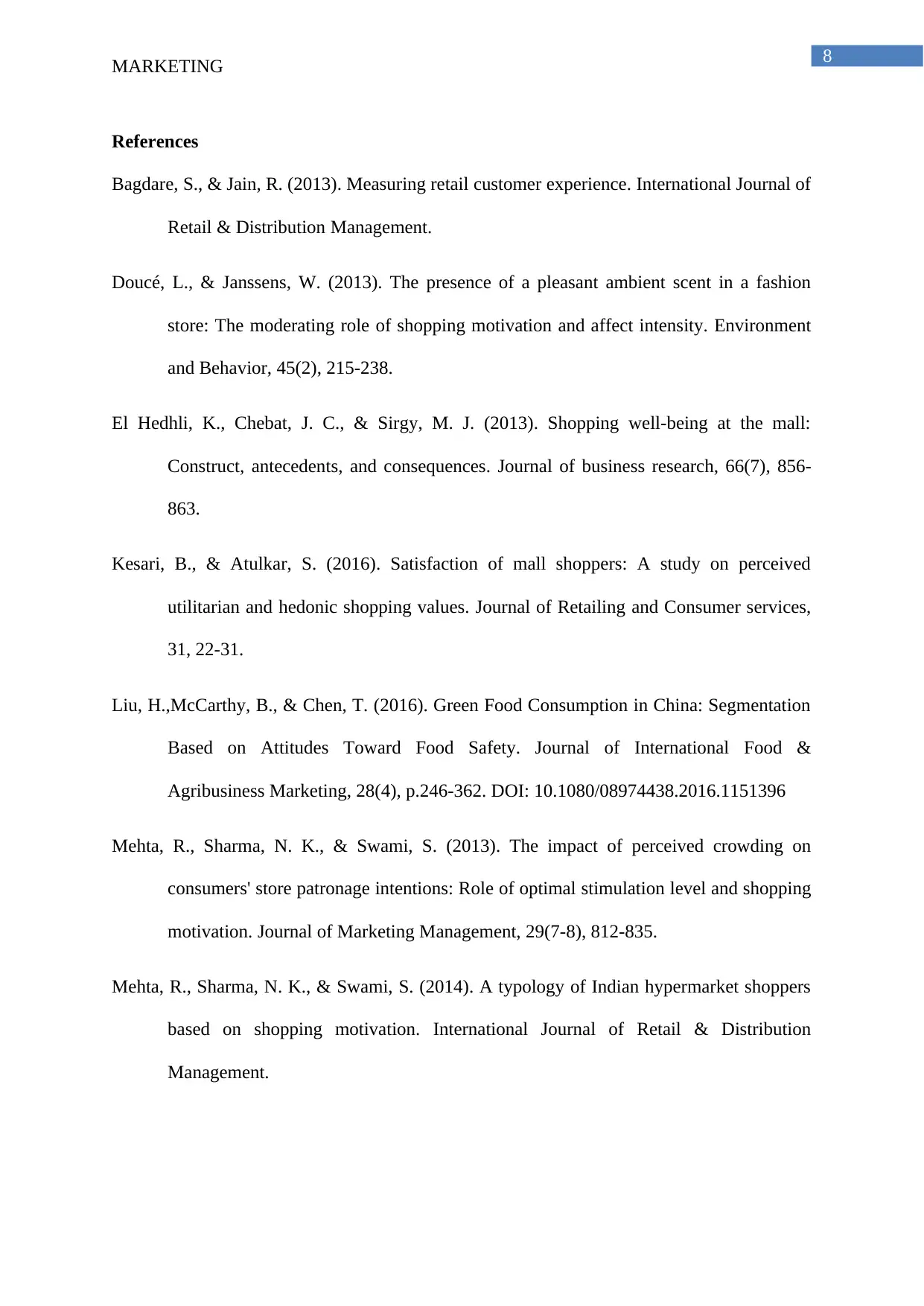
8
MARKETING
References
Bagdare, S., & Jain, R. (2013). Measuring retail customer experience. International Journal of
Retail & Distribution Management.
Doucé, L., & Janssens, W. (2013). The presence of a pleasant ambient scent in a fashion
store: The moderating role of shopping motivation and affect intensity. Environment
and Behavior, 45(2), 215-238.
El Hedhli, K., Chebat, J. C., & Sirgy, M. J. (2013). Shopping well-being at the mall:
Construct, antecedents, and consequences. Journal of business research, 66(7), 856-
863.
Kesari, B., & Atulkar, S. (2016). Satisfaction of mall shoppers: A study on perceived
utilitarian and hedonic shopping values. Journal of Retailing and Consumer services,
31, 22-31.
Liu, H.,McCarthy, B., & Chen, T. (2016). Green Food Consumption in China: Segmentation
Based on Attitudes Toward Food Safety. Journal of International Food &
Agribusiness Marketing, 28(4), p.246-362. DOI: 10.1080/08974438.2016.1151396
Mehta, R., Sharma, N. K., & Swami, S. (2013). The impact of perceived crowding on
consumers' store patronage intentions: Role of optimal stimulation level and shopping
motivation. Journal of Marketing Management, 29(7-8), 812-835.
Mehta, R., Sharma, N. K., & Swami, S. (2014). A typology of Indian hypermarket shoppers
based on shopping motivation. International Journal of Retail & Distribution
Management.
MARKETING
References
Bagdare, S., & Jain, R. (2013). Measuring retail customer experience. International Journal of
Retail & Distribution Management.
Doucé, L., & Janssens, W. (2013). The presence of a pleasant ambient scent in a fashion
store: The moderating role of shopping motivation and affect intensity. Environment
and Behavior, 45(2), 215-238.
El Hedhli, K., Chebat, J. C., & Sirgy, M. J. (2013). Shopping well-being at the mall:
Construct, antecedents, and consequences. Journal of business research, 66(7), 856-
863.
Kesari, B., & Atulkar, S. (2016). Satisfaction of mall shoppers: A study on perceived
utilitarian and hedonic shopping values. Journal of Retailing and Consumer services,
31, 22-31.
Liu, H.,McCarthy, B., & Chen, T. (2016). Green Food Consumption in China: Segmentation
Based on Attitudes Toward Food Safety. Journal of International Food &
Agribusiness Marketing, 28(4), p.246-362. DOI: 10.1080/08974438.2016.1151396
Mehta, R., Sharma, N. K., & Swami, S. (2013). The impact of perceived crowding on
consumers' store patronage intentions: Role of optimal stimulation level and shopping
motivation. Journal of Marketing Management, 29(7-8), 812-835.
Mehta, R., Sharma, N. K., & Swami, S. (2014). A typology of Indian hypermarket shoppers
based on shopping motivation. International Journal of Retail & Distribution
Management.
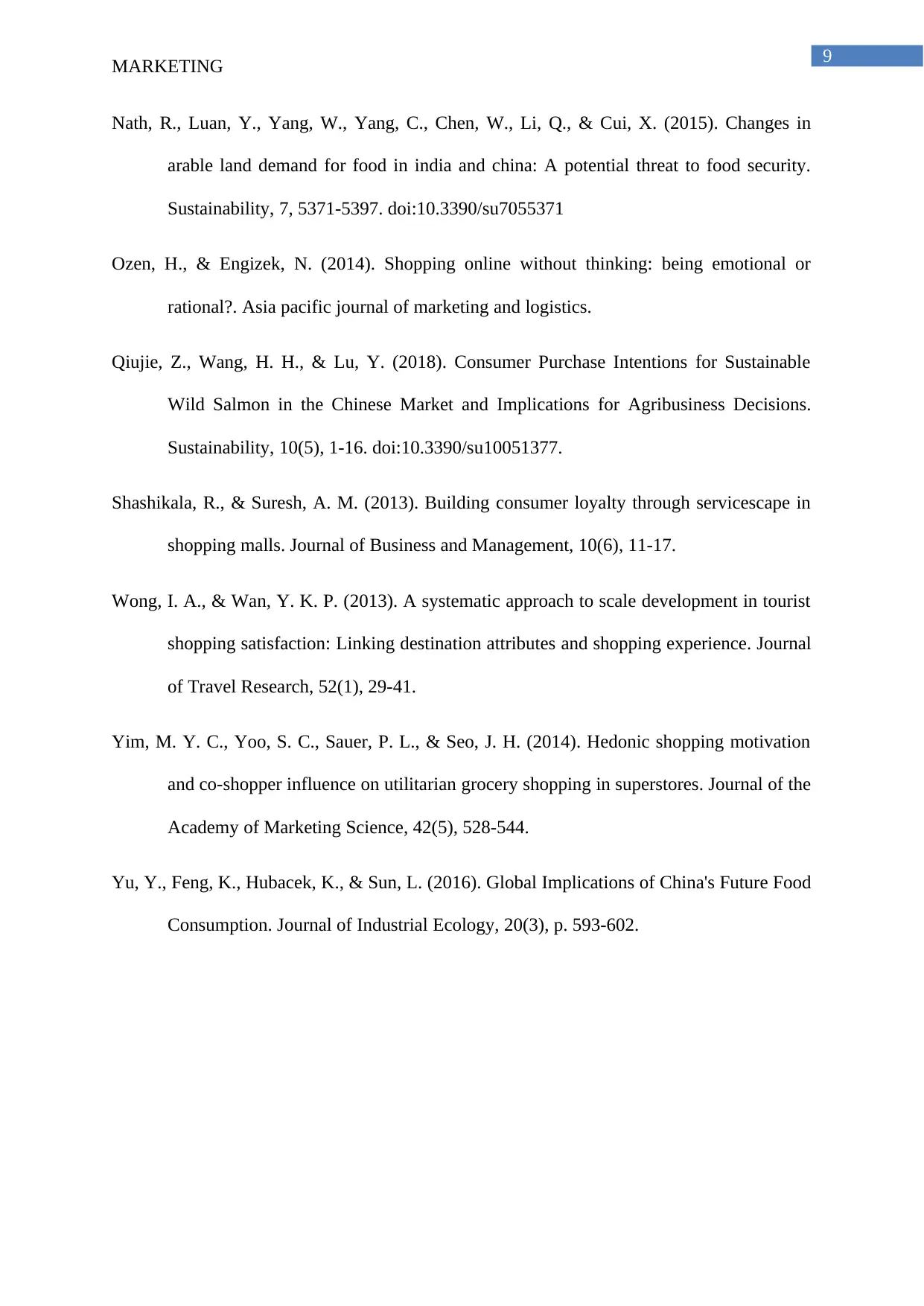
9
MARKETING
Nath, R., Luan, Y., Yang, W., Yang, C., Chen, W., Li, Q., & Cui, X. (2015). Changes in
arable land demand for food in india and china: A potential threat to food security.
Sustainability, 7, 5371-5397. doi:10.3390/su7055371
Ozen, H., & Engizek, N. (2014). Shopping online without thinking: being emotional or
rational?. Asia pacific journal of marketing and logistics.
Qiujie, Z., Wang, H. H., & Lu, Y. (2018). Consumer Purchase Intentions for Sustainable
Wild Salmon in the Chinese Market and Implications for Agribusiness Decisions.
Sustainability, 10(5), 1-16. doi:10.3390/su10051377.
Shashikala, R., & Suresh, A. M. (2013). Building consumer loyalty through servicescape in
shopping malls. Journal of Business and Management, 10(6), 11-17.
Wong, I. A., & Wan, Y. K. P. (2013). A systematic approach to scale development in tourist
shopping satisfaction: Linking destination attributes and shopping experience. Journal
of Travel Research, 52(1), 29-41.
Yim, M. Y. C., Yoo, S. C., Sauer, P. L., & Seo, J. H. (2014). Hedonic shopping motivation
and co-shopper influence on utilitarian grocery shopping in superstores. Journal of the
Academy of Marketing Science, 42(5), 528-544.
Yu, Y., Feng, K., Hubacek, K., & Sun, L. (2016). Global Implications of China's Future Food
Consumption. Journal of Industrial Ecology, 20(3), p. 593-602.
MARKETING
Nath, R., Luan, Y., Yang, W., Yang, C., Chen, W., Li, Q., & Cui, X. (2015). Changes in
arable land demand for food in india and china: A potential threat to food security.
Sustainability, 7, 5371-5397. doi:10.3390/su7055371
Ozen, H., & Engizek, N. (2014). Shopping online without thinking: being emotional or
rational?. Asia pacific journal of marketing and logistics.
Qiujie, Z., Wang, H. H., & Lu, Y. (2018). Consumer Purchase Intentions for Sustainable
Wild Salmon in the Chinese Market and Implications for Agribusiness Decisions.
Sustainability, 10(5), 1-16. doi:10.3390/su10051377.
Shashikala, R., & Suresh, A. M. (2013). Building consumer loyalty through servicescape in
shopping malls. Journal of Business and Management, 10(6), 11-17.
Wong, I. A., & Wan, Y. K. P. (2013). A systematic approach to scale development in tourist
shopping satisfaction: Linking destination attributes and shopping experience. Journal
of Travel Research, 52(1), 29-41.
Yim, M. Y. C., Yoo, S. C., Sauer, P. L., & Seo, J. H. (2014). Hedonic shopping motivation
and co-shopper influence on utilitarian grocery shopping in superstores. Journal of the
Academy of Marketing Science, 42(5), 528-544.
Yu, Y., Feng, K., Hubacek, K., & Sun, L. (2016). Global Implications of China's Future Food
Consumption. Journal of Industrial Ecology, 20(3), p. 593-602.
1 out of 10
Your All-in-One AI-Powered Toolkit for Academic Success.
+13062052269
info@desklib.com
Available 24*7 on WhatsApp / Email
![[object Object]](/_next/static/media/star-bottom.7253800d.svg)
Unlock your academic potential
© 2024 | Zucol Services PVT LTD | All rights reserved.